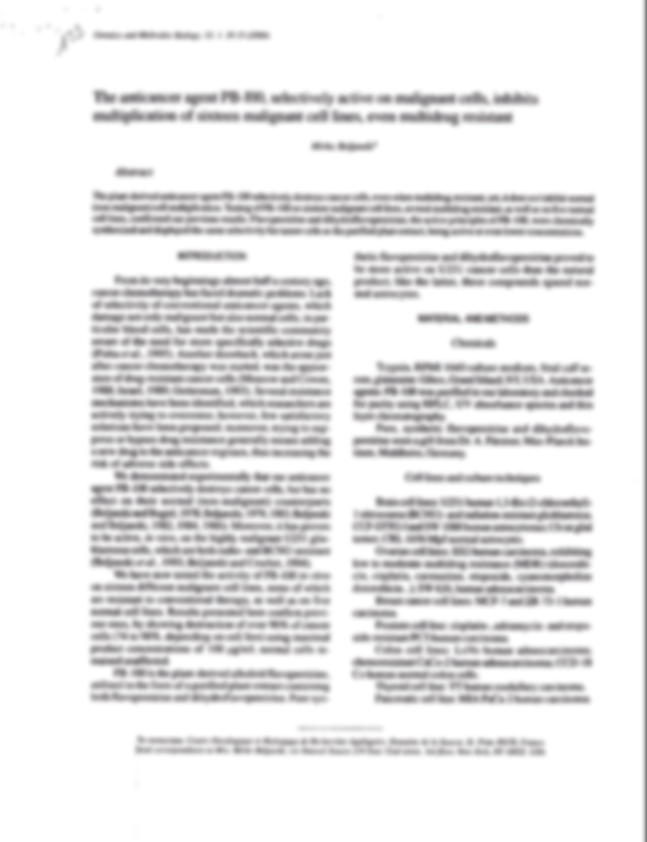33 – Ribonucléosidetriphosphates et synthèses de peptides spécifiques par des enzymes purifiés
Bull. Soc. Chim. Biol., 1961,43, pp.1017-1030.
Available in French only
ABSTRACT: Conclusion of conference : Les enzymes que nous avons isolé et purifiés à partir d’Alcaligenes faecalis sont capables de catalyser en présence d’acides aminés la dégradation des quatre ribonucléosidetriphosphates en orthophosphate et nucléosidediphosphates. Chacun des quatre enzymes est spécifique non seulement d’un type de nucléotide, mais également d’un groupe d’acides aminés. Ces enzymes possèdent le pouvoir de distinguer les acides aminés entre eux. Le processus de libération de l’orthophosphate s’accompagne de la formation de liaisons peptidiques. Une multitude de peptides, combinaisons variées, peuvent être formés par ces systèmes enzymatiques. Les peptides contenant un seul acide aminé peuvent également être formés. Par le mécanisme que nous venons de voir ces enzymes fournissent à partir de ribonucléosidetriphosphates les nucléosidediphosphates qui sont d’excellents substrats pour la polynucléotide-phosphorylase, enzyme capable de synthétiser les acides ribonucléiques. Ces observations suggèrent qu’un lien étroit existerait dans le fonctionnement et l’équilibre entre ces deux systèmes enzymatiques en particulier. Nous revenons à l’idée que des précurseurs communs peuvent être formés et utilisée dans la biosynthèse des protéines et des acides ribonucléiques c’est-à-dire des ribonucléoprotéines constituant majeur des cellules de différentes espèces.
ABSTRACT: Conclusion of conference : Les enzymes que nous avons isolé et purifiés à partir d’Alcaligenes faecalis sont capables de catalyser en présence d’acides aminés la dégradation des quatre ribonucléosidetriphosphates en orthophosphate et nucléosidediphosphates. Chacun des quatre enzymes est spécifique non seulement d’un type de nucléotide, mais également d’un groupe d’acides aminés. Ces enzymes possèdent le pouvoir de distinguer les acides aminés entre eux. Le processus de libération de l’orthophosphate s’accompagne de la formation de liaisons peptidiques. Une multitude de peptides, combinaisons variées, peuvent être formés par ces systèmes enzymatiques. Les peptides contenant un seul acide aminé peuvent également être formés. Par le mécanisme que nous venons de voir ces enzymes fournissent à partir de ribonucléosidetriphosphates les nucléosidediphosphates qui sont d’excellents substrats pour la polynucléotide-phosphorylase, enzyme capable de synthétiser les acides ribonucléiques. Ces observations suggèrent qu’un lien étroit existerait dans le fonctionnement et l’équilibre entre ces deux systèmes enzymatiques en particulier. Nous revenons à l’idée que des précurseurs communs peuvent être formés et utilisée dans la biosynthèse des protéines et des acides ribonucléiques c’est-à-dire des ribonucléoprotéines constituant majeur des cellules de différentes espèces.
32 – Ribonucleoside-5′-triphosphate dependent synthesis of peptides by the purified amino acid incorporation enzyme
Progress in Biophysics and Biophysical Chemistry, Pergamon Press, 1961, 11, p. 238.
Document not available online
Document not available online
31 – Protein biosynthesis by a cell-free bacterial system. IV- Exchange of diphosphonucleosides with homologous triphosphonucleosides by the “amino acid incorporation enzyme
Biochim. Biophys. Acta., 1960,41, pp.111-115.
Available in English only
ABSTRACT: A highly purified preparation of the “amino acid incorporation enzyme” is capable of catalysing the transfer of phosphate from triphosphonucleosides to homologous diphosphonucleosides (ATP-ADP; UTP-UDP; CTP-CDP; GTP-GDP). Thermal inactivation ot this enzyme preparation suggerst the existance of four differnnt and specific enzymes each capable of catalysing the Mg++ dependent exchange of one pair of nucleotides. The purified enzymic preparation is free of diphosphonucleoside kinase (ATP+UDP<=>UTP+ADP), monophosphonucleoside kinase (ATP+UMP<=>ADP+UDP) and myokinase (2 ADP<=>ATP+AMP)
ABSTRACT: A highly purified preparation of the “amino acid incorporation enzyme” is capable of catalysing the transfer of phosphate from triphosphonucleosides to homologous diphosphonucleosides (ATP-ADP; UTP-UDP; CTP-CDP; GTP-GDP). Thermal inactivation ot this enzyme preparation suggerst the existance of four differnnt and specific enzymes each capable of catalysing the Mg++ dependent exchange of one pair of nucleotides. The purified enzymic preparation is free of diphosphonucleoside kinase (ATP+UDP<=>UTP+ADP), monophosphonucleoside kinase (ATP+UMP<=>ADP+UDP) and myokinase (2 ADP<=>ATP+AMP)
30 – Protein biosynthesis by a cell-free bacterial system. III- Determination of new peptide bonds; requirement for the “amino acid incorporation enzyme” in protein biosynthesis
Biochim. Biophys. Acta., 1960, 41, pp. 104-110.
Available in English only
ABSTRACT: The incorporation of 14C amino acids into protein by Alcaligenes faecalis fragments has been demonstrated. Using 14C valine, it was found that most of the incorporated amino acid was within the peptide chains. Alcaligenes fragments have been partially solubilized by treatment with perfluoro octanoate without affecting the incorporation activity. The soluble fraction obtained after this treatment can be replaced by purified “amino acid incorporation enzymes”.
ABSTRACT: The incorporation of 14C amino acids into protein by Alcaligenes faecalis fragments has been demonstrated. Using 14C valine, it was found that most of the incorporated amino acid was within the peptide chains. Alcaligenes fragments have been partially solubilized by treatment with perfluoro octanoate without affecting the incorporation activity. The soluble fraction obtained after this treatment can be replaced by purified “amino acid incorporation enzymes”.
29 – Synthèse de peptides par un système enzymatique en présence de nucléoside – triphosphates
C.R. Acad. Sci., 1960, 250,pp.624-626.
Available in French only
ABSTRACT: Une fraction enzymatique EAA obtenue et purifiée à partir d’Alcaligenes faecalis possède la capacité d’activer l’incorporation des acides aminés dans des fragments subcellulaires de ces mêmes bactéries. Toutefois, elle semble incapable d’activer l’échange entre le PP et l’ATP en présence d’acides aminés, mais catalyse le transfert de l’orthophosphate entre les nucléosides-triphosphates et les nucléosides-diphosphates homologues.
ABSTRACT: Une fraction enzymatique EAA obtenue et purifiée à partir d’Alcaligenes faecalis possède la capacité d’activer l’incorporation des acides aminés dans des fragments subcellulaires de ces mêmes bactéries. Toutefois, elle semble incapable d’activer l’échange entre le PP et l’ATP en présence d’acides aminés, mais catalyse le transfert de l’orthophosphate entre les nucléosides-triphosphates et les nucléosides-diphosphates homologues.
28 – Identification de quatre kinases spécifiques des diphosphonucléosides dans une préparation enzymatique d’origine bactérienne
C.R. Acad. Sci., 1959, 248,pp. 1146-1448.
Available in French only
ABSTRACT: L’ensemble de ces résultats montre que la fraction EAA, par ses quatre réactions d’échange diffère de la synthétase du glutathion qui, ainsi que nous l’avons observé, n’échange que l’ATP avec l’ADP. Ceci explique aisément l’incapacité de la synthétase du glutathion à remplacer notre fraction enzymatique EAA pour l’incorporation des acides aminés. En revanche in est remarquable de constater qu’un système enzymatique impliqué dans l’incorporation d’un grand nombre d’acides aminés se montre capable d’activer le transfert du phosphore entre les quatre principaux nucléotides. Il est difficile de ne pas supposer qu’il y ait une association nécessaire entre cette activité phosphotransférasique et l’activité responsable de l’incorporation des acides aminés.
ABSTRACT: L’ensemble de ces résultats montre que la fraction EAA, par ses quatre réactions d’échange diffère de la synthétase du glutathion qui, ainsi que nous l’avons observé, n’échange que l’ATP avec l’ADP. Ceci explique aisément l’incapacité de la synthétase du glutathion à remplacer notre fraction enzymatique EAA pour l’incorporation des acides aminés. En revanche in est remarquable de constater qu’un système enzymatique impliqué dans l’incorporation d’un grand nombre d’acides aminés se montre capable d’activer le transfert du phosphore entre les quatre principaux nucléotides. Il est difficile de ne pas supposer qu’il y ait une association nécessaire entre cette activité phosphotransférasique et l’activité responsable de l’incorporation des acides aminés.
27 – Protein bio-synthesis by a cell-free bacterial system. II – Further studies on the amino acid incorporation enzyme
Proc. Nat. Acad. Sci., 1958,44, pp. 1157-1161.
Article not available online
Article not available online
26 – Protein biosynthesis by a cell-free bacterial system
Department of Biochemistry, New York University College of Medicine, NY
IV-ème Congrès Intern. Biochim. Vienne, 1958, p.49 – Résumés des commnunications.
Available in French only
ABSTRACT: Indications have been obtained for the presence ot the amino acid incorporation enzyme in the supernatant fraction from rat liver and in the precipitate obtained by acidification of this fraction to pH 5.2 (pH 5 enzymes). Highly purified amino acid incorporation enzyme from A. faecalis completely replaces the pH 5 enzymes in stimulating the incorporation of C14-leucine into protein of rat livermicrosomes. These observations show that the amino acid incorporation enzyme is involved in protein biosyntheses of both mammalian and bacterial cells.
Highly purified preparations of the A. faecalis incorporation enzyme catalyze a rapid, Mg++dependent exchange a radioactive ADP with ATP an activity which appears to be related to their amino acid incorporation activity. This finding may be of significance, since glutathione synthetase, which catalyzes the synthesis of a typical peptide, brings about a similar exchange.
ABSTRACT: Indications have been obtained for the presence ot the amino acid incorporation enzyme in the supernatant fraction from rat liver and in the precipitate obtained by acidification of this fraction to pH 5.2 (pH 5 enzymes). Highly purified amino acid incorporation enzyme from A. faecalis completely replaces the pH 5 enzymes in stimulating the incorporation of C14-leucine into protein of rat livermicrosomes. These observations show that the amino acid incorporation enzyme is involved in protein biosyntheses of both mammalian and bacterial cells.
Highly purified preparations of the A. faecalis incorporation enzyme catalyze a rapid, Mg++dependent exchange a radioactive ADP with ATP an activity which appears to be related to their amino acid incorporation activity. This finding may be of significance, since glutathione synthetase, which catalyzes the synthesis of a typical peptide, brings about a similar exchange.
25 – VII-ème Congrès International de Microbiologie de Stockholm, 1958, Symposium, II.
VII-ème Congrès International de Microbiologie de Stockholm, Sweden, 1958, Symposium, II.
Discussion not available online
Discussion not available online
24 – Protein biosynthesis by a cell-free bacterial system
Proc. Nat. Acad. Sci. Biochemistry, 1958,44, pp. 494-501..
Available in English only
ABSTRACT: Particulate preparations of Alcaligenes faecalis, consisting largely of cell membrane fragments, incorporate amino acids into their proteins. This incorporation, which appears to reflect protein biosynthesis, is driven by oxidative phosphorylation and is stimulated by an enzyme, present in the supernatant extract, which has been isolated in highly purified form. The purified enzyme is free of activating enzymes catalyzing the amino acid-dependent exchange of PP32 with ATP and the same seems to be true of the bacterial particles.
ABSTRACT: Particulate preparations of Alcaligenes faecalis, consisting largely of cell membrane fragments, incorporate amino acids into their proteins. This incorporation, which appears to reflect protein biosynthesis, is driven by oxidative phosphorylation and is stimulated by an enzyme, present in the supernatant extract, which has been isolated in highly purified form. The purified enzyme is free of activating enzymes catalyzing the amino acid-dependent exchange of PP32 with ATP and the same seems to be true of the bacterial particles.




